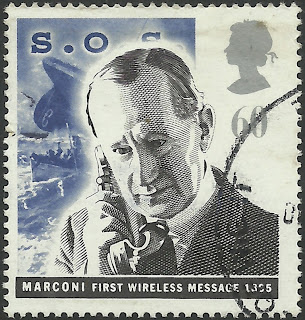Date of Issue: September 05, 1995
Scott #: 1628
Scott #: 1628
Today is May 1st, celebrated in many countries as May Day / Labour Day / International Workers' Day; but what it is to do for a ship stamp collector? well, the term Mayday is an emergency code word used internationally as a distress signal in voice procedure radio communications. It derives from the French venez m'aider, meaning 'come help me'.
It is used to signal a life-threatening emergency primarily by mariners and aviators but in some countries local organisations such as police forces, firefighters, and transportation organizations may also use the term. Mayday calls are made by radio, such as a ship or aircraft's VHF radio. Although a Mayday call will be understood regardless of the radio frequency on which it is broadcast, first-line response organizations, such as the coastguard and air traffic control, monitor designated channels. A Mayday call is roughly equivalent of a morse code SOS, or a telephone call to the emergency services.
S.O.S. - SOS is the commonly used description for the international Morse code distress signal (· · · — — — · · ·). This distress signal was first adopted by the German government in radio regulations effective April 1, 1905, and became the worldwide standard under the second International Radiotelegraphic Convention, which was signed on November 3, 1906 and became effective on July 1, 1908. SOS remained the maritime radio distress signal until 1999, when it was replaced by the Global Maritime Distress Safety System. SOS is still recognized as a visual distress signal.
In popular usage, SOS became associated with such phrases as "save our ship" and "save our souls". These were a later development, a backronym chosen as a mnemonic. Because the SOS signal is a prosign, its respective letters have no inherent meaning: it was chosen because it was easy to remember.
Famous SOS Calls: RMS Titanic - The two radio operators aboard the Titanic—Jack Phillips and Harold Bride—were not employed by the White Star Line, but by the Marconi International Marine Communication Company. Following the sinking of the ocean liner, survivors were rescued by the RMS Carpathia of the Cunard Line. Also employed by the Marconi Company was David Sarnoff, the only person to receive the names of survivors immediately after the disaster via wireless technology. Wireless communications were reportedly maintained for 72 hours between the Carpathia and Sarnoff, but Sarnoff's involvement has been questioned by some modern historians. When the Carpathia docked in New York, Marconi went aboard with a reporter from The New York Times to talk with Bride, the surviving operator. On 18 June 1912, Marconi gave evidence to the Court of Inquiry into the loss of the Titanic regarding the marine telegraphy's functions and the procedures for emergencies at sea. Britain's postmaster-general summed up, referring to the Titanic disaster, "Those who have been saved, have been saved through one man, Mr. Marconi...and his marvelous invention."
Guglielmo Marconi - (25 April 1874 – 20 July 1937) was an Italian inventor, known for his development of Marconi's law and a radio telegraph system.
Stamp Design: This stamp is one of the four stamps issued in 1995 on topic "Pioneers of Communication." I am astonished to learn so many details today from a single stamp. The stamp design shows Mr. Marconi using a radiophone, the term S.O.S., background showing sinking RMS Titanic and passengers on life boat.
Text Source: Wikipedia




















.jpg)















Hey nice info of the Mayday and nice info on SOS ..Wonderful piece of information...
ReplyDeletePrashant
http://stampinformation.blogspot.com/